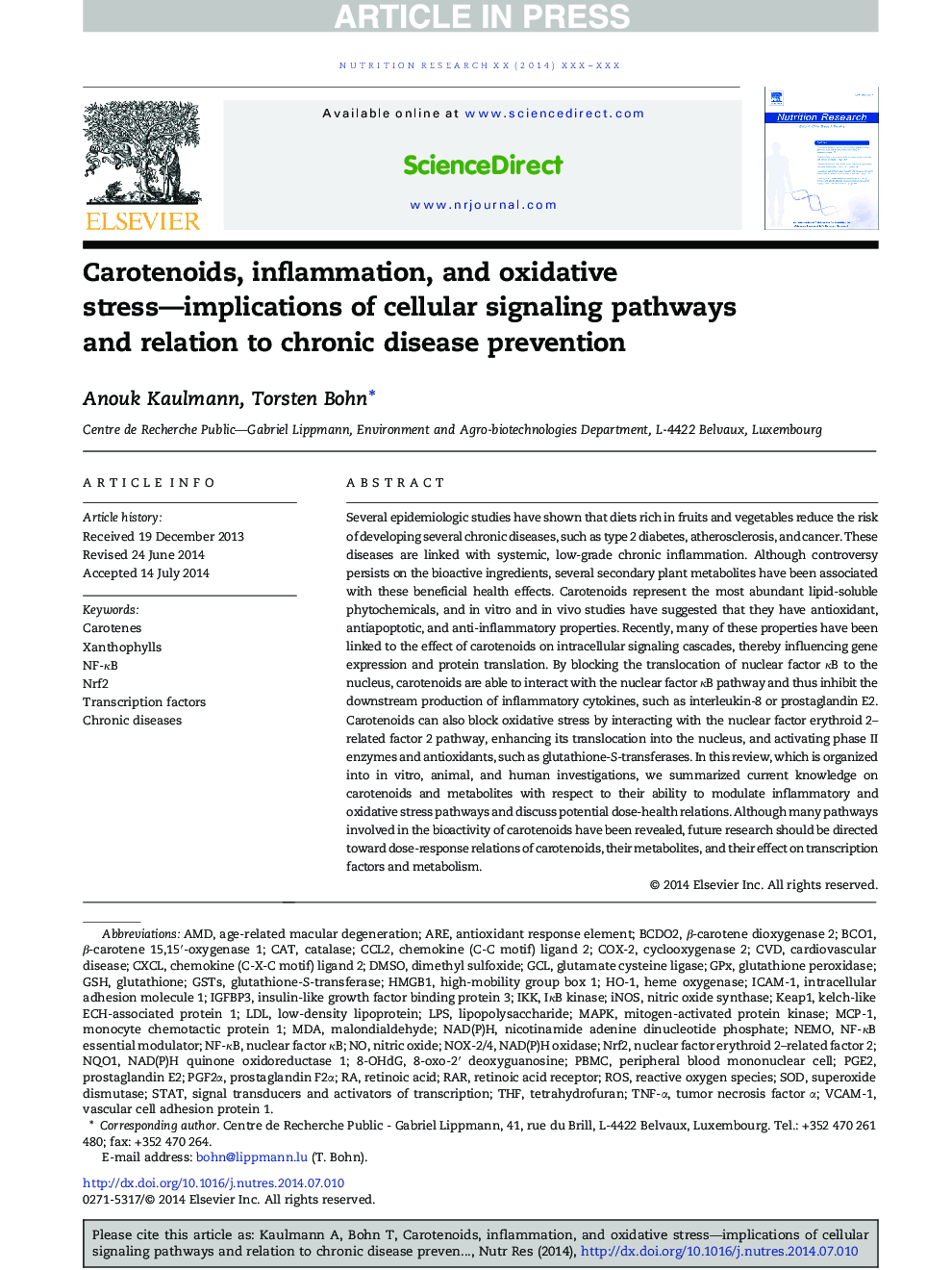| Article ID | Journal | Published Year | Pages | File Type |
|---|---|---|---|---|
| 5904584 | Nutrition Research | 2014 | 23 Pages |
Abstract
Several epidemiologic studies have shown that diets rich in fruits and vegetables reduce the risk of developing several chronic diseases, such as type 2 diabetes, atherosclerosis, and cancer. These diseases are linked with systemic, low-grade chronic inflammation. Although controversy persists on the bioactive ingredients, several secondary plant metabolites have been associated with these beneficial health effects. Carotenoids represent the most abundant lipid-soluble phytochemicals, and in vitro and in vivo studies have suggested that they have antioxidant, antiapoptotic, and anti-inflammatory properties. Recently, many of these properties have been linked to the effect of carotenoids on intracellular signaling cascades, thereby influencing gene expression and protein translation. By blocking the translocation of nuclear factor κB to the nucleus, carotenoids are able to interact with the nuclear factor κB pathway and thus inhibit the downstream production of inflammatory cytokines, such as interleukin-8 or prostaglandin E2. Carotenoids can also block oxidative stress by interacting with the nuclear factor erythroid 2-related factor 2 pathway, enhancing its translocation into the nucleus, and activating phase II enzymes and antioxidants, such as glutathione-S-transferases. In this review, which is organized into in vitro, animal, and human investigations, we summarized current knowledge on carotenoids and metabolites with respect to their ability to modulate inflammatory and oxidative stress pathways and discuss potential dose-health relations. Although many pathways involved in the bioactivity of carotenoids have been revealed, future research should be directed toward dose-response relations of carotenoids, their metabolites, and their effect on transcription factors and metabolism.
Keywords
NEMOGSHGPXXanthophyllsHO-1COX-2AMDiNOSPGE2PGF2αMCP-18-OHdGICAM-1IGFBP3RARGCLIKKHMGB1GSTschemokine (C-X-C motif) ligand 2CXCLVCAM-1NQO1NF-κBNrf2PBMCCCL2MDACATTHFBCO1LPSkeap1DMSOIκB kinaseMAPKNAD(P)HNAD(P)H oxidaseNAD(P)H Quinone Oxidoreductase 1ROSSTATcardiovascular diseaseChronic diseasesTetrahydrofurantumor necrosis factor αhigh-mobility group box 1Dimethyl sulfoxideRetinoic acidCVDSODPeripheral blood mononuclear cellage-related macular degenerationSuperoxide dismutasecyclooxygenase 2Nuclear factor erythroid 2–related factor 2antioxidant response elementTranscription factorsTNF-αnuclear factor κBLow-density lipoproteinLDLlipopolysaccharideglutamate cysteine ligasemalondialdehydesignal transducers and activators of transcriptionNF-κB essential modulatorintracellular adhesion molecule 1Nitric oxidenitric oxide synthasenicotinamide adenine dinucleotide phosphateAREheme oxygenasemonocyte chemotactic protein 1Insulin-like growth factor binding protein 3Kelch-like ECH-associated protein 1vascular cell adhesion protein 1mitogen-activated protein kinaseProstaglandin E2Prostaglandin F2αCatalaseCaroteneschemokine (C-C motif) ligand 2Glutathioneglutathione-S-transferaseglutathione peroxidaseReactive oxygen speciesRetinoic acid receptor
Related Topics
Life Sciences
Biochemistry, Genetics and Molecular Biology
Endocrinology
Authors
Anouk Kaulmann, Torsten Bohn,
